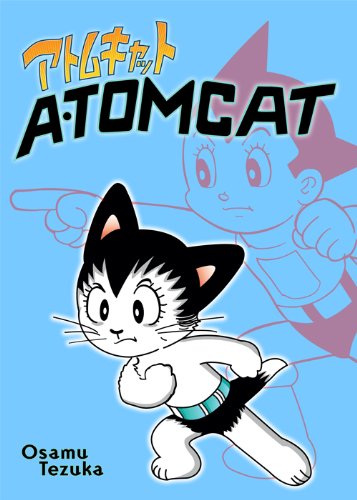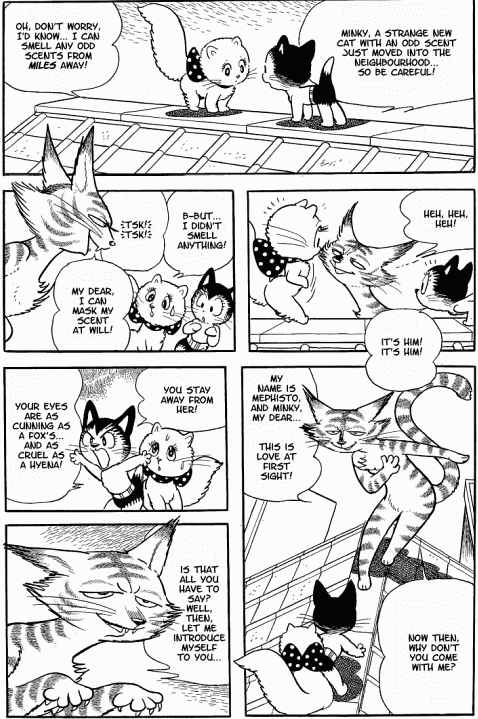Reply to comment
Review: 'Atomcat', by Osamu Tezuka
Posted by Fred Patten on Wed 26 Mar 2014 - 17:40 — The last time I met Osamu Tezuka was at Daicon V, the 25th Japan National Science Fiction Convention, in Osaka on August 24-25, 1986. He was in a good mood, and told me through a helpful fan interpreter that he had just started a new manga that I was sure to like, considering my fondness for funny animals. It was a new version of Astro Boy – turned into a cat! “WHY?”, I asked. He chuckled and said something like, “Why not? It’s important to not take yourself too seriously.”
The last time I met Osamu Tezuka was at Daicon V, the 25th Japan National Science Fiction Convention, in Osaka on August 24-25, 1986. He was in a good mood, and told me through a helpful fan interpreter that he had just started a new manga that I was sure to like, considering my fondness for funny animals. It was a new version of Astro Boy – turned into a cat! “WHY?”, I asked. He chuckled and said something like, “Why not? It’s important to not take yourself too seriously.”
Tezuka had created Tetsuwan Atom (Astro Boy) in 1952 and drawn his adventures until 1968, including the five intense years of the TV series (1963-1966, with production starting in 1962). After that, Tezuka was “Astro Boyed out”, and turned down numerous requests to create new adventures of the robot little boy. He had other stories that he wanted to develop in manga and anime. So, when he got a request from the children’s Smile Comics in 1986 to produce a new manga for young readers, why did he return to Astro Boy, but as a kitten; besides “Why not?”
Well, Atomcat never pretended to be more than a humorous trifle. It was a self-parody, and also a parody of all the talking animal comics where a human little boy or girl has an animal companion to help him or her out. In Atomcat, young Tsugio is the only human who knows that Atom the kitten is not an ordinary kitten, and Atom protects Tsugio from being bullied. Yet Tsugio is such a coward and crybaby that Atom, exasperated, has to take the lead most of the time. Tezuka was very proud of having worked out the English pun Atomcat = A Tomcat, since he claimed not to speak English. He probably also delighted in naming the school bully who always picks on Tsugio, “Gaddafi”. Atomcat was published in the monthly Smile Comics for seven months, seven self-contained stories, from July 1986 to February 1987. The last couple of stories lacked the freshness of the first stories. I suspect that Tezuka had lost interest in Atomcat and was just hacking out the last few stories; he was probably glad to end the series.
I “read” Atomcat in Kodansha’s 400-volume Japanese Osamu Tezuka Complete Manga Works around 1997; that is to say, I looked at the artwork. This current Atomcat edition from Digital Manga’s Platinum Manga has enabled me to read it in English for the first time.
Gardena, CA, Digital Manga Publishing, April 2013, trade paperback $12.95 (194 [+ 9] pages).
It seems ironic that the eight Atomcat stories, written & drawn by Tezuka for little children shortly before he died in February 1989, have only been available for adult manga fans and Tezuka scholars since his death. This Digital Manga edition is intended for both the latter and for American children, but its packaging and the $12.95 price is apt to discourage young readers. The stories are for children, but the book is more likely to be bought by the adult Tezuka fan and by the Tezuka fans who are adults for their children.
 Atomcat was funded for Digital Manga by a very successful Kickstarter campaign that ended on July 21, 2012, raising $49,411. Its initial $20,500 goal, met in only five days, was to publish the American edition of Tezuka’s Unico; the extra money has allowed the publishing of Atomcat and Tezuka’s two-volume Triton of the Sea. This Atomcat book, like the publication in Smile Comics, is in black-&-white, and is in the Japanese right-to-left format.
Atomcat was funded for Digital Manga by a very successful Kickstarter campaign that ended on July 21, 2012, raising $49,411. Its initial $20,500 goal, met in only five days, was to publish the American edition of Tezuka’s Unico; the extra money has allowed the publishing of Atomcat and Tezuka’s two-volume Triton of the Sea. This Atomcat book, like the publication in Smile Comics, is in black-&-white, and is in the Japanese right-to-left format.
Chapter 1, “The Birth of Atomcat”, is the longest at 35 pages. It begins like the typical Astro Boy beginning, but after six pages it turns out that this is the first Astro Boy manga story that eight- or nine-year-old Tsugio is reading. His father approves; he read the same story when he was a boy. In fact, it was the Astro Boy stories that inspired him to become an inventor. Tsugio’s mother sniffs that he just spends all his time playing around building robotic toys. While his parents squabble, Tsugio has to walk alone to school, where he is always ambushed by Gaddafi, the school bully, and his gang. This time, the bullies take Tsugio’s schoolbooks and hide them in a pile of garbage. While looking for them, Tsugio finds an almost-dead kitten whose fur looks like Astro Boy’s marking.
Tsugio nurses the kitten back to health and names him Atom after Tetsuwan Atom. Unfortunately, the kitten acts like all kittens: he sharpens his claws on all the furniture; he plays with and breaks Father’s inventions; he isn’t housebroken and poops everywhere. Tsugio is ordered to get rid of him, but while he is taking Atom away on his bicycle, he gets into a serious traffic accident (similar to Astro Boy’s origin). Only instead of Astro Boy’s fictional scientist father, the car and its honeymooning couple drivers are really disguised space aliens and their spaceship! (Tezuka presumably worked out the most ridiculous deus ex machina that he could think of.)
The kitten is killed, so the aliens try to recreate him from Tsugio’s memory; but their mind-reading machine gets Tsugio’s memories of all of the Astro Boy stories that he’s read, so the alien honeymooners program the revived kitten with all of Astro Boy’s super-powers. The aliens sneak away; the awakened Tsugio can’t believe that Atom the kitten has turned into a feline Astro Boy; and human boy and cat agree to keep this just their secret.
In Chapter 2 and 3, Tsugio meets Erica and her female kitten Munch, and human boy and cat fall in love. Best yet, Erica is Gadaffi’s younger sister, so since she likes Tsugio, Gadaffi lays off him. But Munch can sense that Atom is not a real cat, so his is a one-sided romance until he saves her from Mephisto, an overly suave supernaturally evil cat who plans to work his wiles on her. (Mephisto is a great character. It’s too bad that Tezuka never used him again.)
At this point it becomes clear that despite the “scientific” beginning, Tezuka is going to have Tsugio and Atom run into a series of ghosts and other supernatural menaces, and that all of the regular animals can talk among themselves. In subsequent stories, Atom looks for his mother cat, Tsugio’s father invents a maneki-neko-looking (the “beckoning cat” statue seen in most Japanese restaurants) bomb, Tsugio and Atom try to beat Gaddafi and his gang to pirate treasure, Tsugio and Atom (and Munch) fall afoul of adult weapons smugglers, and they confront genuine ancient Egyptian animal mummies come alive. The book ends abruptly, with nothing resolved.
Even though this is only a humorous trifle, it is a good example of Tezuka’s boys’ comics, which he established as a major stereotype of Japanese manga from the late 1940s until about 1970, when he began to concentrate on mature comics for adults like Ask Adolf! (a.k.a. The Three Adolfs), set in Nazi Germany and military-ruled Japan while they were allies. If you have never read any of Tezuka’s manga, this is a good one to serve as an example. Plus, it’s fun.
P.S.: In the sample page here, Munch is called Minky. That’s because it’s not really from this edition. It’s from another with a different translation. That’s because I couldn’t find any online examples of the interior art from this edition. But aside from the girl cat’s name and the normal differences of two excellent translations, they are identical.